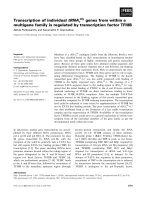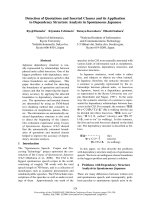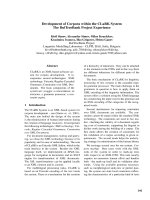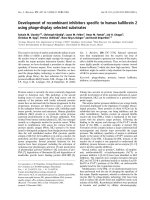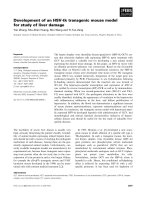Báo cáo khoa học: " Development of liver dysfunction under artificial nutrition: a reason to modify nutrition therapy in the intensive care unit" docx
Bạn đang xem bản rút gọn của tài liệu. Xem và tải ngay bản đầy đủ của tài liệu tại đây (32.46 KB, 2 trang )
Page 1 of 2
(page number not for citation purposes)
Available online />Abstract
Actual research suggests that artificial nutrition in critically ill
patients can be associated with alterations in liver dysfunction
biomarkers such as enzymes and serum bilirubin. In addition to
known patient-dependent and nutrient-dependent factors, the time
of initiation of nutrition therapy seems to influence the risk of
altered biomarkers, whereas age and gender, weight, range of
clinical scores, type of primary diagnosis, necessity for mechanical
ventilation, and the composition of the lipid emulsion used within
total parenteral nutrition had no significant effects. This
commentary analyzes these new results in the light of known
relationships between illness and artificial nutrition therapy.
In this issue Grau and colleagues [1] report the results of a
multicentre study performed in 40 Spanish intensive care
units (ICUs) dealing with the development of hepatobiliary
disorders under artificial nutrition. This problem is not new: in
1971 Peden and colleagues first described total parenteral
nutrition (TPN) as a cause of hepatic dysfunction [2]. Today,
three types of hepatic disorder can be related to parenteral
nutrition (PN) and, to a smaller extent, to enteral nutrition
(EN): steatosis, cholestasis, and gallstones [3]. Prevalence
rates published in recent review papers varied from 25% to
100% in adults and from 7.4% to 84% in pediatric patients
[3,4]. Diagnosis of PN-associated hepatobiliary disease is
mostly based on the analysis of liver enzymes and serum
bilirubin as biomarkers. The definition of cutoff values can
vary between medical units, which may partly explain the
broad range of the prevalence rates.
The etiology and pathogenesis of PN-induced liver dys-
function are not fully known or understood. It is assumed that
both patient-derived and nutrition-derived factors are
involved. Obviously, most patients who need PN and/or EN
are critically ill or have a primary gastrointestinal disorder
such as Crohn’s disease or short bowel syndrome. These
clinical conditions are often associated with disease-specific
metabolic alterations which are seen in themselves as risk
factors for the development of liver dysfunction during the
course of illness: systemic inflammation due to the release of
proinflammatory cytokines, altered membrane function, limited
capability of successful antioxidative defense, or bacterial
overgrowth [4]. Development of liver dysfunction may then be
further promoted by the intravenous supply of a probably
unbalanced or inadequate nutrient solution.
Several nutritional factors have been claimed to increase the
risk for hepatobiliary complications [3]. The strongest
evidence is available for energetic overfeeding: if the caloric
intake is considerably higher than the need of the patient,
increased hepatic fat deposition will occur, stimulated by high
release of insulin. As nicely shown in a current review [5], the
prevalence of PN-associated liver dysfunction in newborn
infants decreased with diminished energy intake. The
composition of energy-providing macronutrients seems to be
of minor importance if the delivery of carbohydrates, fats, and
amino acids remains in a ‘physiological’ range [4]. Single
micronutrients may also be involved in the etiology of liver
dysfunctions [3,4]. There is some evidence that deficiencies
in glutamine, taurine, choline, and carnitine may negatively
influence liver metabolism, resulting in non-physiologically
high biomarker concentrations. In addition, fatty acid
composition [6] and the phytosterol content [7] of the lipid
emulsion used may influence liver metabolism and the risk for
liver dysfunction.
The study by Grau and colleagues [1] adds further
information on potential factors influencing the risk for
development of liver dysfunction. On the basis of a
multivariate analysis, an early use of artificial nutrition (within
24 hours of admission to the ICU) can delay or even avoid the
Commentary
Development of liver dysfunction under artificial nutrition:
a reason to modify nutrition therapy in the intensive care unit?
Peter Stehle
Department of Nutrition and Food Sciences – Nutrition Physiology, University of Bonn, Endenicher Allee 11-13, D-53115 Bonn, Germany
Corresponding author: Peter Stehle,
Published: 19 February 2007 Critical Care 2007, 11:112 (doi:10.1186/cc5679)
This article is online at />© 2007 BioMed Central Ltd
See related research by Grau et al., />EN = enteral nutrition; ICU = intensive care unit; PN = parenteral nutrition; TPN = total parenteral nutrition.
Page 2 of X
(page number not for citation purposes)
Critical Care Vol 11 No 1 Stehle
appearance any type of liver dysfunction in their mixed patient
population. It can be speculated that a delayed nutritional
support of (already malnourished) ICU patients may impair
liver metabolism. Interestingly, age and gender, weight, range
of clinical scores, type of primary diagnosis, necessity for
mechanical ventilation, and the composition of the lipid
emulsion used within TPN had no significant effects on the
prevalence of increased biomarker concentrations. Earlier
data strongly suggest that enteral stimulation providing even
small amounts of liquid can considerably decrease the risk for
hepatic complications by avoiding bacterial overgrowth,
endotoxemia, and abnormal bile acid metabolism [4]. It is
therefore surprising that Grau and colleagues [1] still
observed, in 18% of their patients receiving EN, high levels of
biomarkers. The authors comment that most patients on EN
were medical, needed more mechanical ventilation, and had a
longer ICU stay; they were therefore more seriously ill, which
might explain the unexpectedly high prevalence rate.
However, the possibility cannot be excluded that the enteral
solutions used might not have the correct composition with
regard to key nutrients (see above).
As confirmed in the study [1], there is a potential risk for the
development of liver dysfunction associated with PN or EN,
diagnosed with the use of biomarker analysis. Which
consequences have to be drawn in clinical practice? Should
we retard or even skip artificial support in adult ICU patients?
On the basis of present knowledge the answer is no. Early
nutritional support providing energy and a balanced mixture
of all indispensable and conditionally indispensable nutrients
is a live-saving treatment and must therefore be an integral
component of modern medical therapy. In many cases the
primary disease is the decisive cause of the development of
liver dysfunction; intravenous or even enteral nutritional
support may be an aggravating factor. By modifying present
PN and EN nutrition concepts this latter risk can be
minimized. Sufficient endogenous availability of nutrients and
metabolites such as glutamine, taurine, choline, and probably
carnitine can help to maintain hepatic functions. Because it is
known that ICU patients have a higher need for nutrients
such as glutamine [8], an adequate exogenous supply within
the frame of pharmaconutrition [9] can prevent intracellular
and extracellular deficiencies. Furthermore, it is worth
mentioning that increased concentrations of biochemical
markers such as liver enzymes can occur within 2 to 4 weeks
of PN/EN therapy and in most cases these return to normal
even when PN is continued; a chronic liver dysfunction is
generally not to be expected.
Competing interests
Parts of PS’s long-lasting research work are partially funded
by grants from various industrial partners.
References
1. Grau T, Bonet A, Rubio M, Mateo D, Farré M, Acosta JA, Blesa A,
Montejo JC, Garcia de Lorenzo A, Mesejo A: Liver dysfunction
associated with artificial nutrition in critically ill patients. Crit
Care 2007, 11:R10.
2. Peden VH, Witzleben CL, Skelton MA: TPN. J Pediatr 1971, 78:
180-181.
3. Kumpf VJ: Parenteral nutrition-associated liver disease in
adult and pediatric patients. Nutr Clin Pract 2006, 21:279-290.
4. Fulford A, Scolapio JS, Aranda-Michel J: Parenteral nutrition-
associated hepatotoxicity. Nutr Clin Pract 2004, 19:274-283.
5. Kubota A, Yonekura T, Hoki M, Oyanagi H, Kawahara H, Yagi M,
Imura K, Iiboshi Y, Wasa K, Kamata S, et al.: Total parenteral
nutrition-associated intrahepatic cholestasis in infants; 25
years’ experience. J Pediatr Surg 2000, 35:1049-1051.
6. Baldermann H, Wicklmayr M, Rett K, Banhozer P, Dietze G,
Mehnert H: Changes of hepatic morphology during parenteral
nutrition with lipid emulsion containing LCT or MCT/LCT
quantified by ultrasound. JPEN J Parenter Enteral Nutr 1991,
15:601-603.
7. Ellegard L, Sunesson A, Bosaeus I: High serum phytosterol
levels in short bowel patients on parenteral nutrition support.
Clin Nutr 2005, 24:415-420.
8. Fürst P, Stehle P: What are the essential elements needed for
the determination of amino acid requirements in humans? J
Nutr 2004, 134:1558S-1565S.
9. Stehle P: Pharmaconutrition in critically ill patients. Hosp
Pharm Eur 2007, 1/2:23-24.


